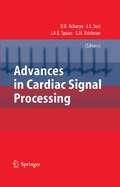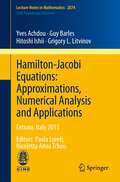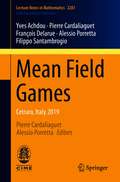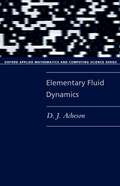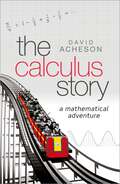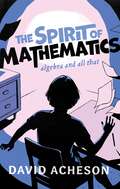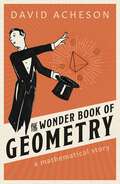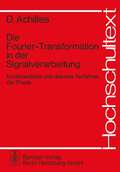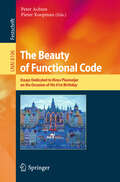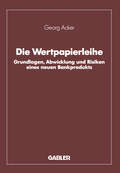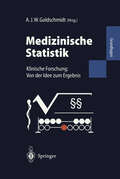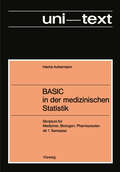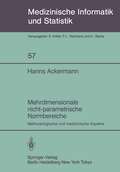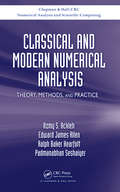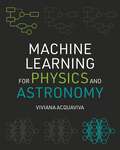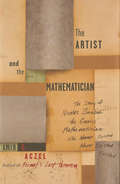- Table View
- List View
Advances in Cardiac Signal Processing
by U. Rajendra AcharyaThis book provides a comprehensive review of progress in the acquisition and extraction of electrocardiogram signals. The coverage is extensive, from a review of filtering techniques to measurement of heart rate variability, to aortic pressure measurement, to strategies for assessing contractile effort of the left ventricle and more. The book concludes by assessing the future of cardiac signal processing, leading to next generation research which directly impact cardiac health care.
Hamilton-Jacobi Equations: Cetraro, Italy 2011, Editors: Paola Loreti, Nicoletta Anna Tchou (Lecture Notes in Mathematics #2074)
by Yves Achdou Guy Barles Hitoshi Ishii Grigory L. LitvinovThese Lecture Notes contain the material relative to the courses given at the CIME summer school held in Cetraro, Italy from August 29 to September 3, 2011. The topic was "Hamilton-Jacobi Equations: Approximations, Numerical Analysis and Applications". The courses dealt mostly with the following subjects: first order and second order Hamilton-Jacobi-Bellman equations, properties of viscosity solutions, asymptotic behaviors, mean field games, approximation and numerical methods, idempotent analysis. The content of the courses ranged from an introduction to viscosity solutions to quite advanced topics, at the cutting edge of research in the field. We believe that they opened perspectives on new and delicate issues. These lecture notes contain four contributions by Yves Achdou (Finite Difference Methods for Mean Field Games), Guy Barles (An Introduction to the Theory of Viscosity Solutions for First-order Hamilton-Jacobi Equations and Applications), Hitoshi Ishii (A Short Introduction to Viscosity Solutions and the Large Time Behavior of Solutions of Hamilton-Jacobi Equations) and Grigory Litvinov (Idempotent/Tropical Analysis, the Hamilton-Jacobi and Bellman Equations).
Mean Field Games: Cetraro, Italy 2019 (Lecture Notes in Mathematics #2281)
by Yves Achdou Pierre Cardaliaguet François Delarue Alessio Porretta Filippo SantambrogioThis volume provides an introduction to the theory of Mean Field Games, suggested by J.-M. Lasry and P.-L. Lions in 2006 as a mean-field model for Nash equilibria in the strategic interaction of a large number of agents. Besides giving an accessible presentation of the main features of mean-field game theory, the volume offers an overview of recent developments which explore several important directions: from partial differential equations to stochastic analysis, from the calculus of variations to modeling and aspects related to numerical methods. Arising from the CIME Summer School "Mean Field Games" held in Cetraro in 2019, this book collects together lecture notes prepared by Y. Achdou (with M. Laurière), P. Cardaliaguet, F. Delarue, A. Porretta and F. Santambrogio.These notes will be valuable for researchers and advanced graduate students who wish to approach this theory and explore its connections with several different fields in mathematics.
Elementary Fluid Dynamics (Oxford Applied Mathematics and Computing Science Series)
by D. J. AchesonThe study of the dynamics of fluids is a central theme of modern applied mathematics. It is used to model a vast range of physical phenomena and plays a vital role in science and engineering. This textbook provides a clear introduction to both the theory and application of fluid dynamics, and will be suitable for all undergraduates coming to the subject for the first time. Prerequisites are few: a basic knowledge of vector calculus, complex analysis, and simple methods for solving differential equations are all that is needed. Throughout, numerous exercises (with hints and answers) illustrate the main ideas and serve to consolidate the reader's understanding of the subject. The book's wide scope (including inviscid and viscous flows, waves in fluids, boundary layer flow, and instability in flow) and frequent references to experiments and the history of the subject, ensures that this book provides a comprehensive and absorbing introduction to the mathematical study of fluid behaviour.
The Calculus Story: A Mathematical Adventure
by David AchesonCalculus is the key to much of modern science and engineering. It is the mathematical method for the analysis of things that change, and since in the natural world we are surrounded by change, the development of calculus was a huge breakthrough in the history of mathematics. But it is also something of a mathematical adventure, largely because of the way infinity enters at virtually every twist and turn... In The Calculus Story David Acheson presents a wide-ranging picture of calculus and its applications, from ancient Greece right up to the present day. Drawing on their original writings, he introduces the people who helped to build our understanding of calculus. With a step by step treatment, he demonstrates how to start doing calculus, from the very beginning.
The Calculus Story: A Mathematical Adventure
by David AchesonCalculus is the key to much of modern science and engineering. It is the mathematical method for the analysis of things that change, and since in the natural world we are surrounded by change, the development of calculus was a huge breakthrough in the history of mathematics. But it is also something of a mathematical adventure, largely because of the way infinity enters at virtually every twist and turn... In The Calculus Story David Acheson presents a wide-ranging picture of calculus and its applications, from ancient Greece right up to the present day. Drawing on their original writings, he introduces the people who helped to build our understanding of calculus. With a step by step treatment, he demonstrates how to start doing calculus, from the very beginning.
The Spirit of Mathematics: Algebra and all that
by David AchesonWhat makes mathematics so special? Whether you have anxious memories of the subject from school, or solve quadratic equations for fun, David Acheson's book will make you look at mathematics afresh. Following on from his previous bestsellers, The Calculus Story and The Wonder Book of Geometry, here Acheson highlights the power of algebra, combining it with arithmetic and geometry to capture the spirit of mathematics. This short book encompasses an astonishing array of ideas and concepts, from number tricks and magic squares to infinite series and imaginary numbers. Acheson's enthusiasm is infectious, and, as ever, a sense of quirkiness and fun pervades the book. But it also seeks to crystallize what is special about mathematics: the delight of discovery; the importance of proof; and the joy of contemplating an elegant solution. Using only the simplest of materials, it conjures up the depth and the magic of the subject.
The Spirit of Mathematics: Algebra and all that
by David AchesonWhat makes mathematics so special? Whether you have anxious memories of the subject from school, or solve quadratic equations for fun, David Acheson's book will make you look at mathematics afresh. Following on from his previous bestsellers, The Calculus Story and The Wonder Book of Geometry, here Acheson highlights the power of algebra, combining it with arithmetic and geometry to capture the spirit of mathematics. This short book encompasses an astonishing array of ideas and concepts, from number tricks and magic squares to infinite series and imaginary numbers. Acheson's enthusiasm is infectious, and, as ever, a sense of quirkiness and fun pervades the book. But it also seeks to crystallize what is special about mathematics: the delight of discovery; the importance of proof; and the joy of contemplating an elegant solution. Using only the simplest of materials, it conjures up the depth and the magic of the subject.
The Wonder Book of Geometry: A Mathematical Story
by David AchesonHow can we be sure that Pythagoras's theorem is really true? Why is the 'angle in a semicircle' always 90 degrees? And how can tangents help determine the speed of a bullet? David Acheson takes the reader on a highly illustrated tour through the history of geometry, from ancient Greece to the present day. He emphasizes throughout elegant deduction and practical applications, and argues that geometry can offer the quickest route to the whole spirit of mathematics at its best. Along the way, we encounter the quirky and the unexpected, meet the great personalities involved, and uncover some of the loveliest surprises in mathematics.
The Wonder Book of Geometry: A Mathematical Story
by David AchesonHow can we be sure that Pythagoras's theorem is really true? Why is the 'angle in a semicircle' always 90 degrees? And how can tangents help determine the speed of a bullet? David Acheson takes the reader on a highly illustrated tour through the history of geometry, from ancient Greece to the present day. He emphasizes throughout elegant deduction and practical applications, and argues that geometry can offer the quickest route to the whole spirit of mathematics at its best. Along the way, we encounter the quirky and the unexpected, meet the great personalities involved, and uncover some of the loveliest surprises in mathematics.
Die Fourier-Transformation in der Signalverarbeitung: Kontinuierliche und diskrete Verfahren in der Praxis (Hochschultext)
by Dietmar AchillesSurveys in Differential-Algebraic Equations I (Differential-Algebraic Equations Forum)
by Achim Ilchmann and Timo ReisThe need for a rigorous mathematical theory for Differential-Algebraic Equations (DAEs) has its roots in the widespread applications of controlled dynamical systems, especially in mechanical and electrical engineering. Due to the strong relation to (ordinary) differential equations, the literature for DAEs mainly started out from introductory textbooks.As such, the present monograph is new in the sense that it comprises survey articles on various fields of DAEs, providing reviews, presentations of the current state of research and new concepts in- Controllability for linear DAEs- Port-Hamiltonian differential-algebraic systems- Robustness of DAEs- Solution concepts for DAEs- DAEs in circuit modeling.The results in the individual chapters are presented in an accessible style, making this book suitable not only for active researchers but also for graduate students (with a good knowledge of the basic principles of DAEs) for self-study.
The Beauty of Functional Code: Essays Dedicated to Rinus Plasmeijer on the Occasion of His 61st Birthday (Lecture Notes in Computer Science #8106)
by Peter Achten Pieter KoopmanThis Festschrift has been published in honor of Rinus Plasmeijer, to celebrate the combined occasion of his 61st birthday and the 25th Symposium on Implementation and Application of Functional Languages, IFL 2013, held in Nijmegen, The Netherlands, in August 2013. Rinus Plasmeijer was the main designer of the lazy functional programming language "Clean" and has always been the leader of the associated research team. He has played a decisive role in making the Radboud University of Nijmegen an important center of research in functional programming by organizing and hosting the first few IFL symposia in Nijmegen. This Festschrift contains 19 scientific essays written by former PhD students of Rinus Plasmeijer and researchers in the field of functional programming who have collaborated with him. The authors write about the influence the beauty of functional programming has had or still has on their work.
Predictive Analytics with KNIME: Analytics for Citizen Data Scientists
by Frank AcitoThis book is about data analytics, including problem definition, data preparation, and data analysis. A variety of techniques (e.g., regression, logistic regression, cluster analysis, neural nets, decision trees, and others) are covered with conceptual background as well as demonstrations of KNIME using each tool. The book uses KNIME, which is a comprehensive, open-source software tool for analytics that does not require coding but instead uses an intuitive drag-and-drop workflow to create a network of connected nodes on an interactive canvas. KNIME workflows provide graphic representations of each step taken in analyses, making the analyses self-documenting. The graphical documentation makes it easy to reproduce analyses, as well as to communicate methods and results to others. Integration with R is also available in KNIME, and several examples using R nodes in a KNIME workflow are demonstrated for special functions and tools not explicitly included in KNIME.
Medizinische Statistik: Klinische Forschung: Von der Idee zum Ergebnis
by H. Ackermann M. Herbold C. Kluss B. Schaaf R. Weiß J. WindelerDie zentralen Aufgaben der Biometrie in der medizinischen Forschung sind mit Hilfe dieses Praxisleitfadens mühelos zu verstehen. Anschaulich werden- die Grundbegriffe der deskriptiven Statistik,- Regression und Korrelation,- die Analyse von Überlebenszeiten,- Probleme der Normalität und Referenzbereiche sowie - das "Intention-to-treat"-Prinzipbeschrieben und durch nützliche Hinweise zum Einsatz von Computer- und Statistikprogrammen ergänzt. Für die Studienplanung enthält das Buch Dokumentationsbögen und Musterprüfpläne.Damit macht dieser anwendungsorientierte Ratgeber Klinikern und Wissenschaftlern aller medizinischen Forschungseinrichtungen grundlegende Statistikkenntnisse leicht verfügbar.
BASIC in der medizinischen Statistik: Skriptum für Mediziner, Biologen, Pharmazeuten ab 1. Semester
by Hanns AckermannMehrdimensionale nicht-parametrische Normbereiche: Methodologische und medizinische Aspekte (Medizinische Informatik, Biometrie und Epidemiologie #57)
by Hanns AckermannClassical and Modern Numerical Analysis: Theory, Methods and Practice (Chapman And Hall/crc Numerical Analysis And Scientific Computing Ser.)
by Azmy S. AcklehClassical and Modern Numerical Analysis: Theory, Methods and Practice provides a sound foundation in numerical analysis for more specialized topics, such as finite element theory, advanced numerical linear algebra, and optimization. It prepares graduate students for taking doctoral examinations in numerical analysis.The text covers the main areas o
Divergence Operator and Related Inequalities (SpringerBriefs in Mathematics)
by Gabriel Acosta Ricardo G. DuránThis Brief is mainly devoted to two classical and related results: the existence of a right inverse of the divergence operator and the so-called Korn Inequalities. It is well known that both results are fundamental tools in the analysis of some classic differential equations, particularly in those arising in fluid dynamics and elasticity. Several connections between these two topics and improved Poincaré inequalities are extensively treated. From simple key ideas the book is growing smoothly in complexity. Beginning with the study of these problems on star-shaped domains the arguments are extended first to John domains and then to Hölder α domains where the need of weighted spaces arises naturally. In this fashion, the authors succeed in presenting in an unified and concise way several classic and recent developments in the field. These features certainly makes this Brief useful for students, post-graduate students, and researchers as well.
Machine Learning for Physics and Astronomy
by Viviana AcquavivaA hands-on introduction to machine learning and its applications to the physical sciencesAs the size and complexity of data continue to grow exponentially across the physical sciences, machine learning is helping scientists to sift through and analyze this information while driving breathtaking advances in quantum physics, astronomy, cosmology, and beyond. This incisive textbook covers the basics of building, diagnosing, optimizing, and deploying machine learning methods to solve research problems in physics and astronomy, with an emphasis on critical thinking and the scientific method. Using a hands-on approach to learning, Machine Learning for Physics and Astronomy draws on real-world, publicly available data as well as examples taken directly from the frontiers of research, from identifying galaxy morphology from images to identifying the signature of standard model particles in simulations at the Large Hadron Collider.Introduces readers to best practices in data-driven problem-solving, from preliminary data exploration and cleaning to selecting the best method for a given taskEach chapter is accompanied by Jupyter Notebook worksheets in Python that enable students to explore key conceptsIncludes a wealth of review questions and quizzesIdeal for advanced undergraduate and early graduate students in STEM disciplines such as physics, computer science, engineering, and applied mathematicsAccessible to self-learners with a basic knowledge of linear algebra and calculusSlides and assessment questions (available only to instructors)
Topics in Global Real Analytic Geometry (Springer Monographs in Mathematics)
by Francesca Acquistapace Fabrizio Broglia José F. FernandoIn the first two chapters we review the theory developped by Cartan, Whitney and Tognoli. Then Nullstellensatz is proved both for Stein algebras and for the algebra of real analytic functions on a C-analytic space. Here we find a relation between real Nullstellensatz and seventeenth Hilbert’s problem for positive semidefinite analytic functions. Namely, a positive answer to Hilbert’s problem implies a solution for the real Nullstellensatz more similar to the one for real polinomials. A chapter is devoted to the state of the art on this problem that is far from a complete answer. In the last chapter we deal with inequalities. We describe a class of semianalytic sets defined by countably many global real analytic functions that is stable under topological properties and under proper holomorphic maps between Stein spaces, that is, verifies a direct image theorem. A smaller class admits also a decomposition into irreducible components as it happens for semialgebraic sets. During the redaction some proofs have been simplified with respect to the original ones.
Research Directions in Symplectic and Contact Geometry and Topology (Association for Women in Mathematics Series #27)
by Bahar Acu Catherine Cannizzo Dusa McDuff Ziva Myer Yu Pan Lisa TraynorThis book highlights a number of recent research advances in the field of symplectic and contact geometry and topology, and related areas in low-dimensional topology. This field has experienced significant and exciting growth in the past few decades, and this volume provides an accessible introduction into many active research problems in this area. The papers were written with a broad audience in mind so as to reach a wide range of mathematicians at various levels. Aside from teaching readers about developing research areas, this book will inspire researchers to ask further questions to continue to advance the field.The volume contains both original results and survey articles, presenting the results of collaborative research on a wide range of topics. These projects began at the Research Collaboration Conference for Women in Symplectic and Contact Geometry and Topology (WiSCon) in July 2019 at ICERM, Brown University. Each group of authors included female and nonbinary mathematicians at different career levels in mathematics and with varying areas of expertise. This paved the way for new connections between mathematicians at all career levels, spanning multiple continents, and resulted in the new collaborations and directions that are featured in this work.
Advances in Mathematical Sciences: AWM Research Symposium, Houston, TX, April 2019 (Association for Women in Mathematics Series #21)
by Bahar Acu Donatella Danielli Marta Lewicka Arati Pati Saraswathy Rv Miranda Teboh-EwungkemThis volume highlights the mathematical research presented at the 2019 Association for Women in Mathematics (AWM) Research Symposium held at Rice University, April 6-7, 2019. The symposium showcased research from women across the mathematical sciences working in academia, government, and industry, as well as featured women across the career spectrum: undergraduates, graduate students, postdocs, and professionals. The book is divided into eight parts, opening with a plenary talk and followed by a combination of research paper contributions and survey papers in the different areas of mathematics represented at the symposium: algebraic combinatorics and graph theory algebraic biologycommutative algebraanalysis, probability, and PDEstopologyapplied mathematicsmathematics education
The Artist and the Mathematician: The Story Of Nicolas Bourbaki, The Genius Mathematician Who Never Existed
by Amir D. AczelNicolas Bourbaki, whose mathematical publications began to appear in the late 1930s and continued to be published through most of the twentieth century, was a direct product as well as a major force behind an important revolution that took place in the early decades of the twentieth century that completely changed Western culture. Pure mathematics, the area of Bourbaki's work, seems on the surface to be an abstract field of human study with no direct connection with the real world. In reality, however, it is closely intertwined with the general culture that surrounds it. Major developments in mathematics have often followed important trends in popular culture; developments in mathematics have acted as harbingers of change in the surrounding human culture. The seeds of change, the beginnings of the revolution that swept the Western world in the early decades of the twentieth century - both in mathematics and in other areas - were sown late in the previous century. This is the story both of Bourbaki and the world that created him in that time. It is the story of an elaborate intellectual joke - because Bourbaki, one of the foremost mathematicians of his day - never existed.
